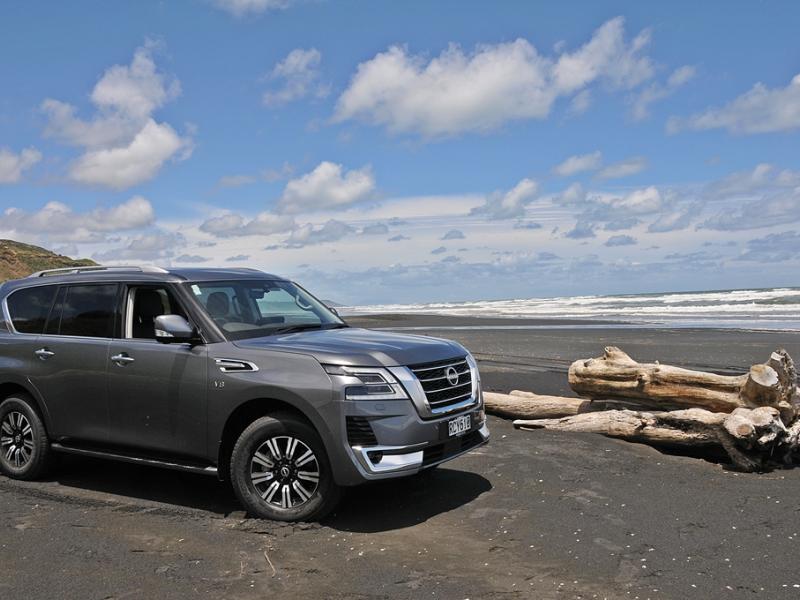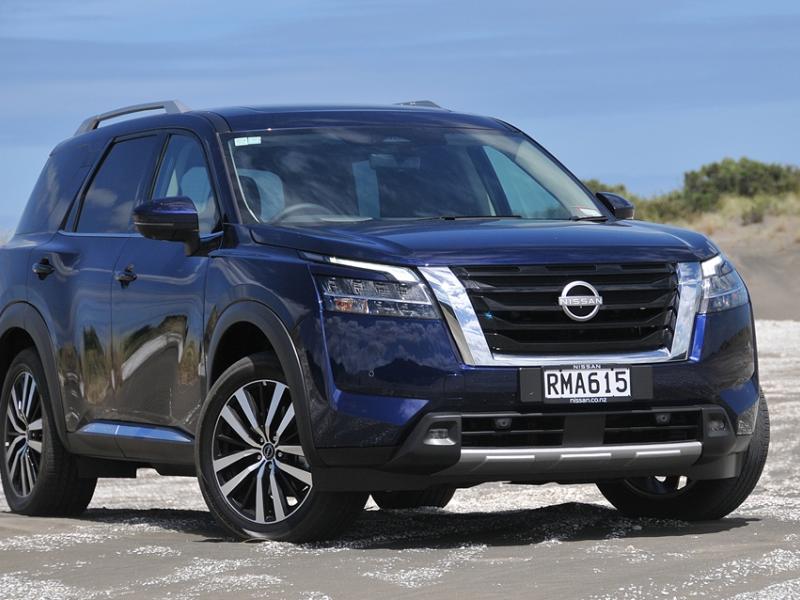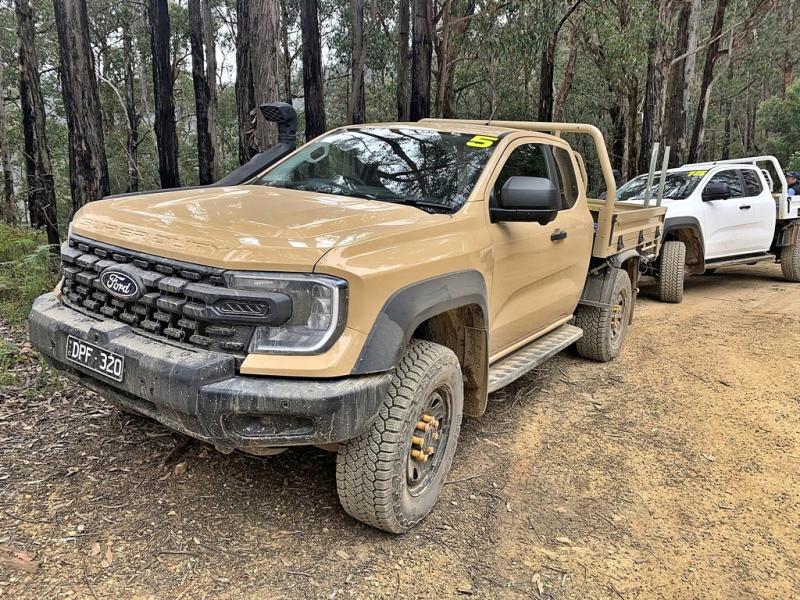‘Ford Tough’ is the message that greets you on the digital instrument cluster when you climb behind the wheel of a new Ranger, and it’s a statement that hasn’t come lightly. During testing the Ranger was ‘driven’ 1,250,000km with 10,000km of desert and 625,000km of off-road driving. It was also tested in temperatures varying from -50 degrees Celsius and up to 50 degrees Celsius. Admittedly, we didn’t go to those extremes during this dual test, but still pushed it harder than your general townie or tradie would.
With six models and three powertrains to play with, the Ford Ranger line-up in NZ is reasonably extensive, however, we opted for the XLT with a 2.0l biTurbo diesel engine (154kW/500Nm) mated to a 10-speed auto. It’s powerful enough for most purposes and yet more efficient than some recently released PHEV utes.
Our double cab pickup came in Lightning Blue, not a colour you’d miss on the worksite or mall, and its substantial dimensions (around 5.4m length, 1.85m width and 1.85m height) cast an imposing shadow on other road users.
Design-wise, the Ranger is every bit a work and play vehicle. The grille is prominent and bookended with signature ‘C-clamp’ daytime running lamps, while its square-ish front and almost horizontal bonnet, more than fills the rear-view mirror of those ahead of it.
Side steps, roof rails and 17-inch wheels wrapped in Bridgestone 255/70 R17 Dueler A/T rubber, are the profile highlights, while the rear sports smaller C-Clamp LED lights, a feather-light and embossed tailgate and a box step on the rear quarter to aid with loading and unloading.
While on the matter of loading, the bed itself is big enough to fit a standard sized ‘Euro’ pallet, has a built-in ruler, a power outlet and inserts for clamps. Plus, it’s got 3.5-tonne towing for those with toys.
The interior is a mix of utilitarian and modernity, and a bit upmarket for a working ute. The coast-to-coast dash is easy to wipedown and there are ample storage areas for all your documents and valuables. The reach and height adjustable steering wheel is leather trimmed, the seats are cloth and there’s dual-zone climate control with rear air vents.
Unfortunately, there’s no wireless charging in this model, just a couple of ports to chuck your cable in, however, the instrument cluster is eight-inches colour and digital and the infotainment comes via a 10.1-inch portrait touchscreen that’s really easy to connect to and navigate around, with Sync 4A, a 360-degree camera view and a raft driver and safety aids to keep the whole team safe and entertained.
On the road, the Ranger rides well with its substantial footprint keeping it well within the lines, even when cornering at speed, and the torquey engine/10-speed auto combination meant that the Ranger was never lost, or hunting for the ideal gear. The EPAS steering offered up just the right amount of weight and feedback, without feeling too removed from what was going on below, underling the overall sense of control.
The driving position is both comfortable and natural, with the window ledge fitting the right arm perfectly and the eShifter and console are a nice place for your left arm/hand to sit (obviously not both at the same time). The cabin is quiet for a diesel ute and its elevated ride height means that visibility all round is great.
The Ranger’s ADAS suite does let you know if you’ve ventured off the tarmac, but doesn’t make a meal of it and switching between 2WD and 4WD on the move is a simple turn of the dial on the centre console. In fairness, the suspension is firm, something that was welcomed on the tarmac, but a little jarring on the corrugated ruts of Klondyke’s unsealed surfaces.
Our off-road portion of the day really showcased just how capable the Ranger really is. With approach, breakover and departure angles of 29/25/21 degrees respectively, a ground clearance of 229mm and a wading depth of 800mm, it barely noticed the deep mud ruts and chassis twists we put it through. From a driver’s perspective, all I had to do was engage low ratio 4WD and let the Ranger do its thing.
The off-road route we chose had the added thrill of being rained on the previous night, however, the Bridgestone Dueler AT rubber mated to the Ranger’s highly advanced 4WD system didn’t skip a beat. What’s more, travelling at low speed meant that the 360-degree camera view was enabled, so not only was I ‘along for the ride’, I could have grabbed some popcorn and watched it all unfold in colour too.
The XLT may well be towards the lower end of the Ford Ranger line-up, but it’s still well spec’d and incredibly capable. What it lacks in terms of leather furniture, wireless connectivity and off-road menus, it makes up for by being a ute that is handsome enough for work and play, but enough of a brute to take to the places that many other off-roaders would fear to tread.
Mark Baker
The current Ranger reset the premium end of the ute market when it arrived and solidified the truck’s long run at the top of the sales charts. That’s all well known.
The ‘Ranger range’ now extends through XL, XLT, Sport, Tremor, Wildtrak all the way to the V6 petrol Raptor. It’s still possible to buy a 4x2 Ranger, and it’s still possible to buy a single cab or super cab version. Most sales, though, are double cab and 4WD.
The XLT is one of the most popular Rangers, and has Ford’s latest bi-turbo 2.0-litre four-cylinder diesel engine, the ten-speed auto and hi-lo transfer care with selectable 4WD rather than the full-time 4WD available on models further up the range.
The Ranger’s interior is modern and ergonomically clever. The dash is of course dominated by the large new centre screen. This interior is more SUV than working ute pick-up. The multi-layer digital instrument cluster. A panel to the right provides driver-selected vehicle info. The manually-adjusted seats are finished in robust fabric, and the interior mats are off-road-friendly chunky rubber units.
Cab ergonomics start with an ideal three-point climb into the cab: sturdy side steps, a well-positioned grab handle on the A-pillar and the seat itself. Not all manufacturers get it so right.
Small touches make all the difference – like a damped tailgate that doesn’t tear off the user’s arm as it comes down, and a heap of cargo tie-down points in the wellside. Like those door handles, hidden in the arm-rest until needed. Like the wellside’s tray-corner steps that allow easy access to the cargo area.
A 3,270mm wheelbase and wider track transforms the handling of the next-Gen Ranger.
The wheel/tyre package is close to ideal. The 17-inch alloys look ‘right’ in the wheelarches, and the A/T treads are suitably chunky and hint at the capability of the truck in all conditions. They never clogged in our riverside tracks, through mud sections or later up in the forestry skid clearings.
The Ranger is perfectly at home on narrow, rough roads like the Klondyke, which was wearing the effects of recent storms. It communicates well through both steering and seat and stays on-line over corrugations and through potholes.
Driven alongside the Triton in these conditions it feels slightly more deliberate at the front, more ‘planted’ but less agile. Payback for this is the Ranger’s excellent on-road manners at highway speeds – this is where the Ranger is simply the class leader.
Meanwhile off-road, with more tyre sidewall to soak up impacts and a visibly more aggressive tread, the Ranger coped admirably with our rutted riverside track. Once, it slipped sideways into a rutted section (operator error) but simply churned its way on out. Mudholes on our wee track never looked like stopping the truck.
Turning onto tarmac as we headed out, the A/T treads shed their mud payload within a few metres and were ready to go.
The run into Port Waikato is one of those superb rural roads the region hides from view. Every corner reveals a different view and the Ranger is simply glued to the road at legal speeds. Turning up into the hills on Klondyke Road the battering of the storm is obvious. Clay is seeping upward through the gravel, drawn up by the passing of countless logging trucks. Further up, the road narrows further and there are spectacular views of the Waikato estuary and river mouth, though there’s no chance for the driver to enjoy them. The narrow road, blind corners, shifty surfaces and numerous slips take care of that.
Ranger is sublime in these conditions, enabling us to dodge the numerous herds of goats, solo rabbits and groups of juvenile pheasants that appear around corners. These are places where the Ranger’s all-wheel disc brakes are a huge advantage, providing strong and well-modulated braking on pine needles, clay and muddy patches.
Confession time: we ran up Klondyke in rear wheel drive, trusting the truck’s excellent road manners to keep us safe. That did mean Dave in the Triton had to hang back a bit, as the Ranger was ‘disturbing the road surface a bit’. It would definitely have been more sensible though slightly less fun to flick into 4-hi.






